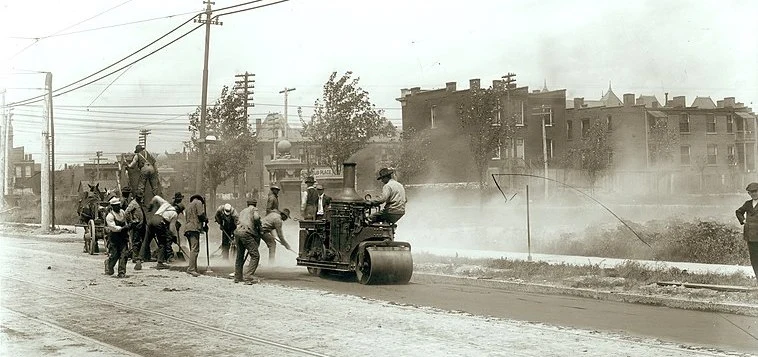In life it’s always important to reflect on where you came from. To look back on your roots, whether in life or in business, you can always learn something from the past. And you know what? It’s high time we did that here in the asphalt industry.
The first use of asphalt can be found in 625 B.C. as timeless as a good idea is, apparently so is road paving! Babylonians used asphalt to help pave their roads. It’s also been found to be used by romans to seal reservoirs, aqueducts, even baths.
Fast forward to 1595, Europeans exploring South America discovered the Pitch Lake in Trinidad, the largest natural asphalt deposit in the world. Pitch Lake is estimated to contain 10 million tons of asphalt and is around 100 acres in size. There is a native story about how this lake was formed. The story consists of a tribe of indigenous people that were celebrating a victory over a rival tribe. They we’re partying too hard when they ended up cooking and eating a sacred hummingbird which possessed the souls of their ancestors. Their God angered, reduced the village into the lake that stands there today.
After the revolution of 1830 in France, there was a surge of usage in asphalt. It was used in the construction of pavements, flat roofs, and lining cisterns. This was the first recorded usage of asphalt for street use.
In 1870 the United States finally adopted the practice of using asphalt to pave roads when a Belgian chemist Edmund J. Desmelt paved the road right outside of City Hall in Newark N.J.
1907, this was the year production of petroleum asphalt took over natural asphalt. Cars where becoming more popular, and demand for roads increased. This lead to innovations in producing and laying asphalt, such as drum mixers and mechanical spreaders.
In 1956 the U.S congress passed the Interstate Highways Act, giving $51 billion to states for road work. Since pavers were getting more work they became more innovative, allowing the development of electronic leveling controls, vibratory steel-wheel rollers, and extra-wide pavers that allowed paving two lanes at once.
When the national energy crisis was happening during the 1970s, there was a big push for conservation of natural resources. This helped push for the recycling of asphalt which is the United States most recycled material!
Finally in 1986 the National Center for Asphalt Technology at Auburn University in Alabama was established. This provided a new centralized and systematic way of diving into asphalt research. In fact NCAT recently opened a new research center and is now the world’s leading institution for asphalt pavement research.

